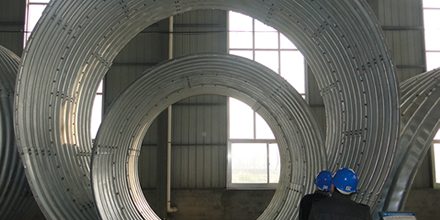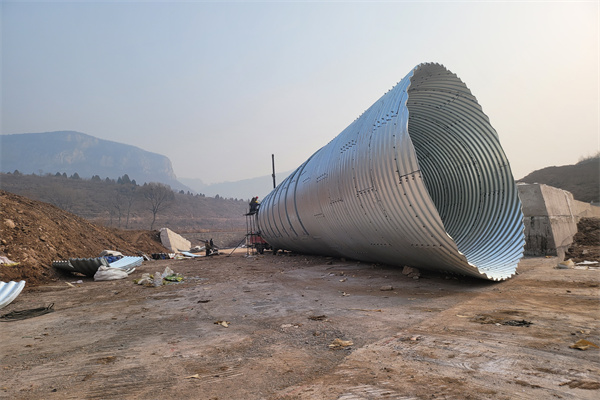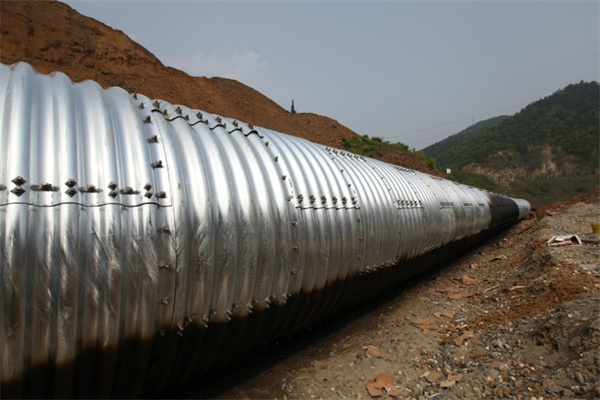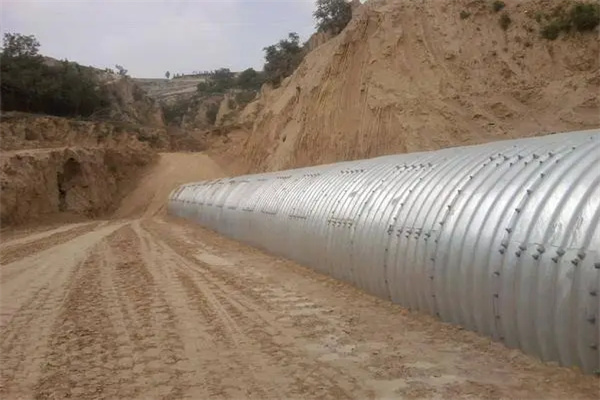Usage Environment And Construction Techniques Of Corrugated Pipe Culvert
Requirements For Usage Environment Of Corrugated Pipe Culvert
1. The use of corrugated pipe culvet in gullies in mountainous and hilly areas can replace bridges culverts, with fast construction speed and cost savings.
2. When filling high soil in mountainous areas, corrugated pipe culvert can be used for construction. In the construction of high fill highways, due to difficulties such as transportation of building materials, on-site dumping to the bottom of the ditch, and the inability to construct temporary access roads, the characteristics of corrugated culvert pipe shorter construction time, and fast installation speed can be utilized, while also avoiding problems such as uneven settlement caused by back filling.
3. The roads built in the goaf of coal mines can cause varying degrees of ground subsidence and uneven settlement due to underground mining, which can cause varying degrees of damage to general cement structures. Steel corrugated pipe culverts are a flexible structure, and corrugated pipes have excellent lateral compensation displacement characteristics in the structure, so it can fully utilize the strong tensile and deformation properties of steel, and have great resistance to deformation and settlement. So the corrugated pipe culvert is better to used on construction of road built in the coal mines.
4. In cases where the bearing capacity of the foundation is low, there is no need for special treatment of the foundation,only needs to fill a certain thickness of sand and gravel cushion layer is replaced.
5. In some areas, there are many paroxysmal rainstorm, which are easy to damage bridge and culvert structures, but concrete structures cannot be reused after being washed out. New culverts must be built, resulting in disconnection and reconstruction, increasing construction costs and long construction time. Corrugated pipes can be reused after being destroyed by water.
6. Quick repair project for old culverts.Due to uneven settlement in some areas causing varying degrees of damage to culverts, such as stone arch culverts, excavating and repairing them in high fill areas takes a long time, and cutting off or repairing access roads increases costs. The construction of the inner cement circular pipe is difficult, and it is difficult to fill cement mortar between the circular pipe culvert and the old arch culvert. The use of corrugated culvert pipes can be pushed forward after being connected outside the culvert, with no gaps at the connection point; Drill holes on the side of the pipe to fill with rubble and spray mortar to increase the integrity of the pipe culvert and the original culvert; In addition, the corrugated culvert pipe body is lightweight and easy to construct; Clean the foundation while advancing during construction to ensure the safety of construction personnel.
7. When there is no access road near the mountain, corrugated pipes can be used for segmented construction to ensure early opening time.
8. When filling shallow soil, corrugated pipe culverts can be used for construction. Due to shallow soil filling, cement circular pipe culverts are prone to cracking during construction. Corrugated pipes are a flexible structure that can adapt to deformation and the requirements of heavy vehicle traffic.
9. Replace the small bridge with corrugated pipe porous use.
10. When two roads intersect in a three-dimensional cross, a steel corrugated plate channel can be used.
Construction Techniques Of Corrugated Pipe Culvert
The foundation of steel corrugated pipe culvert is generally a flexible foundation, and the settlement of the culvert base is consistent with the settlement of the roadbeds on both sides. Therefore, in road project construction, it is not necessary to separately treat the foundation of the corrugated pipe. In sections with poor geological conditions such as soft soil areas, the basic principle is to treat the roadbed and the culvert base in the same way. The excavation of the foundation pit should be carried out with the proposed steel corrugated pipe culvert having a width three times that of the steel corrugated pipe culvert. If the construction site is too small, at least a working space of 1.2m or more beyond the span should be ensured. This is not only convenient for assembly, but also conducive to back filling and compaction around the steel corrugated pipe culvert.
The thickness of the foundation should be around 30-80cm from the bottom of the steel corrugated pipe culvert, and it is recommended to use sandy soil or gravel or crushed stone soil with good permeability and particle size distribution to achieve the design requirements for compactness. The maximum particle size of the material shall not exceed 1/2 of the wavelength or 50mm.
A coarse sand cushion layer with a thickness of 7-15cm and a maximum particle size of 12mm should be laid in the contact area with the corrugated steel plate.
Basic Requirements Of Corrugated Pipe Culvert
Reserve 0.3-1% on the top surface of the foundation. Pre arching of corrugated pipes buried on general soil foundations, through a period of time, there is often a certain degree of subsidence, and it is often greater in the middle of the pipeline than at both ends. Therefore, the pipe body of the corrugated pipe laid under the embankment should have a reserved arch. Its size is determined by factors such as the possible settlement of the foundation soil, the longitudinal slope of the culvert bottom, and the height of the fill soil. It can usually be 0.3% to 1% of the pipe length, and should not exceed 2% at most to ensure that there are no depressions or landslides in the middle of the pipeline.
 Products
Products Application
Application




